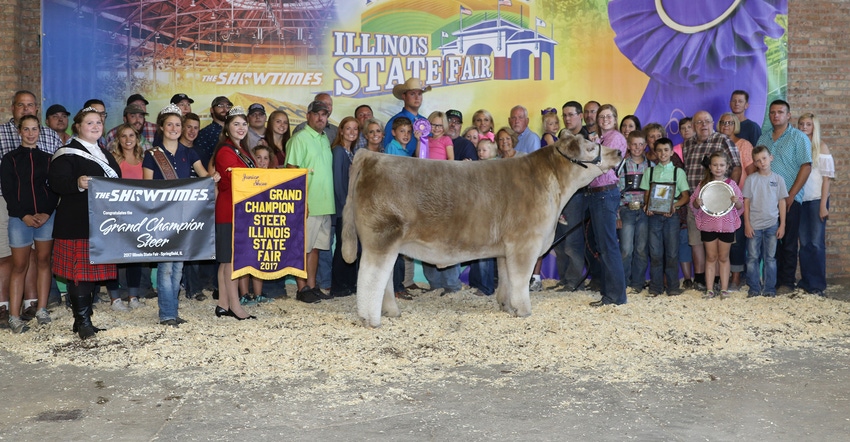
When bidders congregated at the 2017 Illinois State Fair Sale of Champions, they raised their hands to bid more than $154,000. This year, for the first time, that money was distributed to more than just the champion exhibitors.
The Illinois Department of Agriculture changed its rules on how money would be disbursed in early 2017. No longer would 80% go to the exhibitor, with the remaining 20% divided between Illinois 4-H and FFA; instead, the money is distributed among champion, reserve champion, various breed champions, the Land of Lincoln Purebred Breeders Association, 4-H and FFA.
“I think it went really well, says Kevin Gordon, Illinois State Fair manager. “One of our focuses here was to distribute more monies to the juniors who work extremely hard on their projects. An additional 50-plus kids were able to receive monies for their hard work.”
Here’s a look at the new formula:
• 50% of the auction funds go to the grand champion junior exhibitor
• 15% to the reserve champion junior exhibitor
• 15% divided evenly among the exhibitors of other breed champions
• 10% to the Illinois 4-H Foundation
• 10% to the Illinois FFA Foundation
Land of Lincoln sale money distribution is similar:
• 50% of the auction funds go to the junior exhibitor
• 12.5% to the reserve champion exhibitor
• 12.5% divided evenly among the exhibitors of other breed champions
• 10% to the Illinois 4-H Foundation
• 10% to the Illinois FFA Foundation
• 5% to the Land of Lincoln Purebred Breeders Association
The Livestock Working Group, a coalition of industry experts convened by IDOA in early 2017 to re-evaluate livestock exhibition rules, neither recommended nor weighed in on the changes to the Sale of Champions.
Lower bids?
But not everyone thinks the new distribution formula made for a better Sale. John Slayton has organized the Sale of Champions for 27 years, helping coordinate bidders and donors with a team of volunteers. He points to the 2016 sale, where the grand champion steer brought $104,000; the 2017 grand champion steer brought $50,000. Slayton says the difference came because the 2016 winner raised additional local money.
“I think as far as raising money, it hurt overall because of the lack of community input by animal,” Slayton says. “It caused people not to go back to their community and raise money, because that money would be disbursed over a number of exhibitors who that family might not even know.”
Gordon says he has received no feedback, either positive or negative, from either exhibitors or donors/bidders. He adds that while he’s not certain, the decrease in total bids in 2017 could be attributed to the distribution system.
“The biggest thing is the grand champion will go out and raise additional funds by themselves,” Gordon says. “Gov. [Bruce] Rauner gave $50,000 both years. Last year we sold the grand champion steer for $104,000 — $50,000 from the governor, $54,000 raised by the exhibitor.”
What happens if buyers don’t pay? The short answer: The exhibitor doesn’t get paid. Though rare, that scenario occurred in 2016. Chicago financier R.J. D’Orazio never paid the $20,000 he pledged in the bid for the grand champion steer, despite repeated requests from organizers. When a Chicago Tribune reporter started making calls, D’Orazio wired $40,000, which included $20,000 for last year and $20,000 for this year. With the final dollars in, Gordon says IDOA “cut the check from last year and made the exhibitor whole.”
In addition to the money bid in the auction, the 10 grand champion exhibitors in 2017 each receive scholarships totaling $6,000. AT&T donated $10,000, which was split into 10 $1,000 scholarships, and CME Group gave $50,000, which was split into 10 $5,000 scholarships.
Gordon and his team are looking ahead to next year.
“There’s going to be challenges every single year — making sure we go back to our donors and trying to acquire new donors,” he says.
“The bottom line is it has to be enjoyable for our exhibitors to participate.”
Breaking it down
Here’s a look at how money was distributed to the junior exhibitors in the Sale of Champions and Parade of Champions in 2017.
GRAND CHAMPION STEER, sold for $50,000
Olivia Caldwell, exhibitor: $25,000
Keegan Murphy, reserve champion: $7,500
Five breed champions each: $1,500
Illinois 4-H: $5,000
Illinois FFA: $5,000
LAND OF LINCOLN CHAMPION STEER, sold for $29,100
Adam Miller, exhibitor: $14,550
Peyton Richie, reserve champion: $3,637.50
Land of Lincoln Purebred Breeders Association: $1,455
Three breed champions each: $1,212.50
Illinois 4-H: $2,910
Illinois FFA: $2,910
GRAND CHAMPION BARROW, sold for $25,000
Cooper Bertolino, exhibitor: $12,500
Adam Gradert, reserve champion: $3,750
11 breed champions each: $340.90
Illinois 4-H: $2,500
Illinois FFA: $2,500
LAND OF LINCOLN CHAMPION BARROW, sold for $19,000
Bryce Bedeker, exhibitor: $9,500
Jenna Wheeler, reserve champion: $2,375
Land of Lincoln Purebred Breeders Association: $950
Nine breed champions each: $263.88
Illinois 4-H: $1,900
Illinois FFA: $1,900
GRAND CHAMPION WETHER, sold for $8,000
Kashen Ellerbrock, exhibitor: $4,000
Kagney Collins, reserve champion: $1,200
Eight breed champions each: $150
Illinois 4-H: $800
Illinois FFA: $800
LAND OF LINCOLN CHAMPION WETHER, sold for $5,350
Halie Runner, exhibitor: $2,675
Cole Ellerbrock, reserve champion: $668.75
Land of Lincoln Purebred Breeders Association: $267.50
Five breed champions each: $133.75
Illinois 4-H: $535
Illinois FFA: $535
GRAND CHAMPION AND CHAMPION LAND OF LINCOLN MEAT GOAT, sold for $4,250
Tara Hummel, exhibitor: $2,125
Kadie Hummel, reserve champion: $637.50
One breed champion: $637.50
Illinois 4-H: $425
Illinois FFA: $425
RESERVE CHAMPION AND RESERVE LAND OF LINCOLN MEAT GOAT, sold for $2,750
Kadie Hummel, exhibitor: $1,718.75
One breed champion: $343.75
Land of Lincoln Purebred Breeders Association: $137.50
Illinois 4-H: $275
Illinois FFA: $275
GRAND CHAMPION RABBIT PEN, sold for $3,000
Dax Gentes, exhibitor: $1,950
Nicholas Helmos Jr., reserve champion: $450
Illinois 4-H: $300
Illinois FFA: $300
GRAND CHAMPION POULTRY MEAT PEN, sold for $5,250
Caroline Gill, exhibitor: $3,412.50
Faith Foster, reserve champion: $787.50
Illinois 4-H: $525
Illinois FFA: $525
About the Author(s)
You May Also Like






